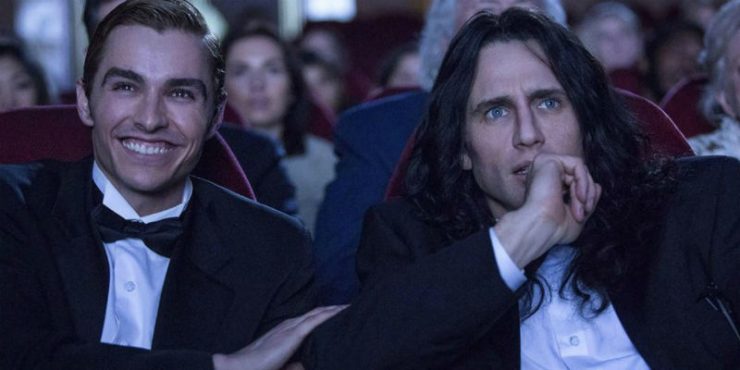I can’t speak to the artistic competence of Tommy Wiseau. I’ve never seen The Room and frankly, I don’t plan to. As for James Franco, I’d say that as a director he’s done very little to prove that he’s substantially better than Wiseau. His films are mostly small experiments, as if he’s being given a chance to play in America’s most expensive toy store. This might be why The Disaster Artist works. He does not see himself as particularly superior to the notoriously atrocious material he’s examining. As a comedy, it very rarely has a laugh at Wiseau or The Room’s expense, which is more than can be said for most of the people that watch The Room.
Franco directs, but he also plays Wiseau himself, equipped with a wig, a prosthetic nose and an ambiguously European accent that is the butt of many of the movie’s jokes. This is actually one of Franco’s greatest performances, instilled with a surprising amount of humanity. His Wiseau is brash, funny (unintentionally, of course) and seemingly on the spectrum. The film opens on a San Francisco acting class, where Greg (Dave Franco) struggles through Samuel Beckett, while Tommy is able to perform an impassioned, but nonsensical version of Tennessee Williams. No one is confused enough to think that Tommy has talent but Greg admires his confidence enough to befriend him and ask him how he performs so fearlessly.
Greg is Greg Sestero, another actor in The Room and also one of the co-writers of the book The Disaster Artist, the half-memoir, half-making-of account that is the source material for Franco’s film. It chronicles Greg and Tommy’s friendship that evolves from reading scenes in a diner to moving to Los Angeles together. Tommy already has an apartment in Los Angeles, with no explanation on how he can afford it, and when they move in, Tommy even offers Greg the bedroom. He hangs a curtain in the living room for his own space. When Greg asks Tommy about his accent, he responds that its because he’s from New Orleans. When Greg asks Tommy his age, Tommy responds that he’s the same age as him. All Tommy really wants is Greg’s friendship, which Greg will happily give in exchange for a place in LA.
Things become complicated when Greg starts to have success as an actor, while Tommy is universally rejected. When Greg starts dating Amber (Alison Brie), Tommy lashes out, seemingly betrayed by the only person he can reasonably call a friend. Greg soothes him by saying that they can make their own movie, create their own path to stardom. The result is The Room. Tommy writes the script, planning to play the lead and casting Greg in another major role. They go to rent equipment, and Tommy states that he wants to flat-out buy all of the cameras, shooting on film and digital at the same time. He pays for sets, above-and-below-the-line talent with a money account that seems to be a bottomless pit. When anyone inquires about where the money comes from, they’re met with the usual allusiveness.
The Disaster Artist then becomes two different things. The first is a comedy about how The Room was just as big of a nightmare behind the camera as it is in front. As the film begins shooting, the crew is an ensemble including Seth Rogen as a sarcastic script supervisor, Paul Scheer as a begrudged cinematographer, Jacki Weaver as an older actress trying to make logic out of her illogical lines, and Ari Graynor as a leading lady who has an incredibly awkward sex scene with Tommy that nearly leads to a fistfight. Zac Efron, Nathan Fielder and Josh Hutcherson round out the rest of The Room‘s troubled cast. The second is an unwavering argument for individual vision, for Tommy’s incompetent but undeniable role in his own brand of movie stardom. Tommy seeks stardom at any cost, and what he ends up with is the notoriety as the director behind the worst movie of all time.
The film becomes sentimental about The Room in a way that I found hard to relate to. It’s best moments are when it focuses on the hopeless journey of Tommy’s character, his sad obsession with Greg and his ceaseless confidence in his own ability as a filmmaker. How that confidence bumps up against the reality of his skills is the movie’s biggest conflict and its greatest source of comedy. Still, The Disaster Artist is a very sweet film, filled with great comedy and a terrific lead performance. Like Ed Wood, it is able to find value in an artist’s unorthodox style even if it ends in a terrible product. Of course, Ed Wood was a director who at least knew the basics of filmmaking. Wiseau is completely clueless. That cluelessness has become endearing as The Room has been one of our most-watched midnight movies. The Disaster Artist does good by a bad film and ends up, interestingly enough, to be pretty good.
Directed by James Franco










